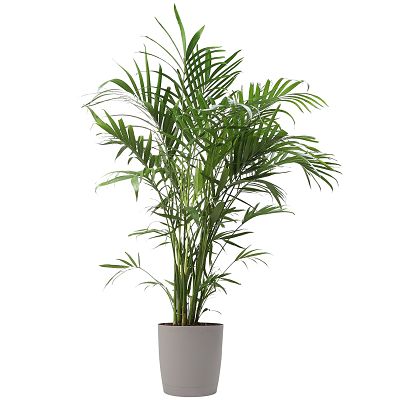This post may contain affiliate links. As an Amazon Associate we earn from qualifying purchases.
If you want to grow majesty palm indoors, you’ll find some challenges. But the rewards of learning and applying that knowledge to the plant are immense.
We receive many emails from readers who love their houseplants, evidence that gardening doesn’t necessarily have to be restricted to the outdoors.
Among the most popular plants to grow indoors are palms. But, they can be challenging, depending on which you choose. The majesty palm (Ravenea rivularis) is one of the more challenging to grow indoors.
Native to Madagascar, the majesty palm is a slow grower, which is what you want when growing a palm indoors. In the wild, however, it can grow as tall as 40 feet. The biggest problem with trying to grow an indoor potted majesty palm is its thick trunk – it doesn’t appreciate being restricted in a pot.
It’s also a high-maintenance palm, requiring lots of water, fertilizer and light. If you haven’t yet purchased a majesty palm to grow indoors, scroll down to the end of this post to learn about better alternatives.
If you’ve already purchased a majesty palm, read on to learn how to care for it indoors.
Things you’ll need:
- Potting soil
- Fertilizer
- Water
- Spray bottle
- Neem oil
- Pruners (the best!)
Make your own potting soil
The experts at the University of Oklahoma claim that the potting media is the most important aspect of your success with the indoor majesty palm. The plant thrives in rich soil.
They suggest you make your own, by combining two parts of sand, two parts of peat moss and one part loam. The latter is a term that gets thrown around a lot in the gardening community. Just what is loam?
Some garden experts think that the stuff sold as “garden soil” at the big gardening centers is loam. I disagree.
The best introduction to loam I’ve seen is on Wikipedia, of all places:
“Loam is soil composed mostly of sand, silt, and a smaller amount of clay. By weight, its mineral composition is about 40–40–20% concentration of sand–silt–clay, respectively.”
Want to buy loam soil? Sure, do a quick shopping trip online. We’ll wait for you.
Or, you can follow a recipe from the highly-respected palm nursery man at Jungle Music:
- 10% amended topsoil (has about 1/3 high quality topsoil and 2/3 humus)
- 15% pumice #2
- 15% 0 – 1/8 inch pine bark
- 15% nitrolized redwood shavings (good luck finding this! Definition at apollowoodproducts.com)
- 20% perlite #2 (medium, 1/4 inch to 3/8 inch)
- 10% coarse washed sand, #12
- 15% coarse peat moss
“To this formulae above I add per cubic yard: one lb. Dolomite, one lb. Osmocote (14-14-14), and 1 lb. of a microelement mix called Micromax Plus,” he adds.
Another alternative is to purchase soil specifically labeled for palms. We like the ingredients in this Espoma soil. Have some perlite and peat moss on hand.
Moisten the planting mix. When it is completely wet, water heavily to determine how quickly it drains. If it’s too slow, add perlite and if it drains too quickly, add more peat moss. Add the extras in small amounts until the soil retains enough moisture, but isn’t soupy.
Water, light, fertilizer and humidity for majesty palms
Once potted up, place the majesty palm in an area of the home that receives lots of full sunlight. Yes, it can tolerate some light shade during the daytime, but the more sunlight, the better.
Ensure that the soil is kept moist at all times. Not soggy – but it should have the moisture content of a well-wrung sponge. If fronds begin browning, it’s asking for more water and if they are yellow, the soil is too moist.
Another important care requirement is humidity so you’ll need to grow it near other plants or buy a humidifier. Learn additional ways to provide humidity to your indoor plants, here.
Most all palms are magnets for mealy bugs and mites. We like Neem oil to clear up infestations. Again, if you’re on a tight budget consider purchasing a concentrate that you can mix with water and pour into your own spray bottle. Bonide sells one at Amazon.com.
If you used the time-released fertilizer at planting, hold off on fertilizing for about three months, then use a balanced fertilizer, preferably one that contains iron, at label recommended rates.
One of the best you can buy, commercially, is PALMGAIN, available at Amazon and some gardening centers. Discontinue fertilizing in winter.
If you need to prune your majesty palm, use care. Wait until the fronds are completely dead and then cut them 1 to 3 inches from the trunk. For young palms, use micro snips to avoid damage.
Majesty palm alternatives
Since majesty palms are so easily propagated by growers, they dominate the houseplant sections of stores such as Lowe’s and Home Depot. They’re also attractively inexpensive. This is what lures folks into buying them.
If you’d prefer an indoor palm that requires less maintenance, consider one of the following:
Cat palm (Chamaedorea cataractarum)
Cat palms don’t need a lot of sunlight when grown indoors. In fact, set it near a window with a light curtain, or near an east- or south-facing window and it will be happy.
The cat does, however, require consistently moist soil (in nature, it grows along riverbanks). Buy it at Amazon.com.
Parlor palm (Chamaedora elegans)

A gorgeous palm, the parlor palm thrives indoors and, best of all, it tolerates low light levels. It will, however, require you to keep an eye on the soil’s moisture level. Not as thirsty as the majesty palm, allow the top inch of soil to dry slightly before watering.
Lady palm (Rhapis excelsa) SHOP NOW
SHOP NOW
If you’re looking for a true easy-grower (and she’s gorgeous!), consider the lady palm. It is tolerant of low light levels, although does better in indirect sun. Like most palms, the lady likes moist soil. The roots are primarily at the bottom of the pot, according to plant care expert Gary Antosh, so feeling the top of the soil to ensure it is wet won’t cut it.
You’ll need to stick your finger into the soil or, better yet, get a bamboo pole and push it halfway into the pot. If it comes out dry, the lady needs a drink.



